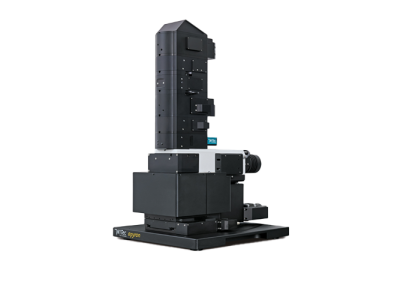XPS allows elemental and chemical analysis of both conductive and insulating materials
High depth resolution and good elemental sensitivity. Samples are analyzed in an ultra-high-vacuum chamber (some specialized instruments allow surface analysis at near-atmospheric pressure). Changes in surface elemental composition with depth can be documented nondestructively by recording composition while varying sample tilt relative to the analyzer (this technique is called angle-resolved depth profiling). Compositional changes with depth down to a few hundred nm can be documented by recording composition while using an ion gun to gradually remove surface layers. The spatial distribution of elements or chemistries on a surface can be mapped as well, with ultimate lateral resolution defined by the XPS instrument used.
MIT.nano’s PHI Versaprobe II XPS has a floating voltage argon single-ion gun for depth profiling and a cluster-ion C60 gun as well. The cluster-ion gun permits depth profiling softer materials which would be too damaged by single-ion bombardment. Other features of this XPS are a portable transfer vessel so that processed samples can be loaded into the XPS without exposure to air; an in situ heat/cold stage; and X-ray induced secondary electron imaging (SXI), which aids significantly in setting up for small area analysis.
- Source: Monochromated Al K-alpha X-radiation
- Signal: photoelectrons and Auger electrons
- Operating vacuum range: low 10-8 to 10e-9 Torr
- Sample holder diameter: 25 mm or 60 mm
- Samples: vacuum-compatible thin films, powders, or bulk materials
- Compatible for conductive and insulating samples
- Maximum sample height: 1 cm
- X-ray spot size: 10 um to 200 um
- Maximum analysis area: 1400 x 1400 um
- Information depth: 1 to 10 nm
Elemental sensitivity: 0.1 to 0.01 atomic per cent
Accessory in-situ holders- Ion guns: Argon, C60 cluster source
- Inert atmpsphere compatible transfer vessel with 25 mm sample holder
- In situ heat/cold stage (-120C to 500C)
- Elemental and chemical analysis of surfaces and interfaces
- Depth profiling to a practical depth of few hundred nm
- Chemical shifts information
- Non distructive angle resolved analyses to the maximum depth of ~10nm
Libby Shaw
13-4149
60 Vassar Street
Cambridge, MA
Charlie Settens, PhD
13-4013
60 Vassar Street (rear)
Cambridge, MA

Only qualified users can reserve and use the instrument.
13-4137
60 Vassar Street (rear)
Cambridge, MA

